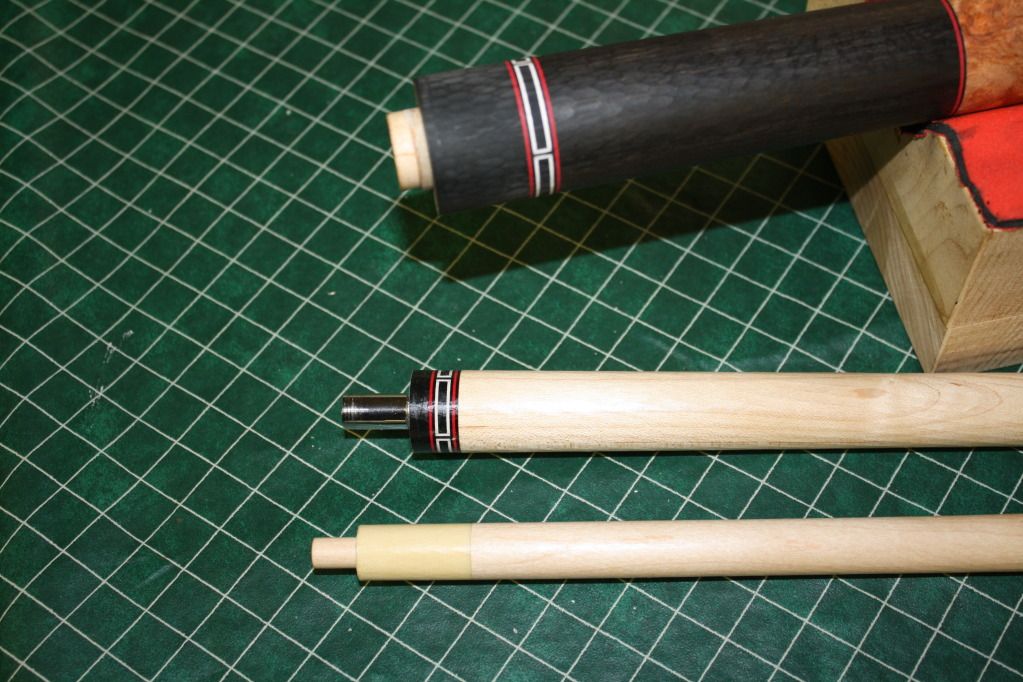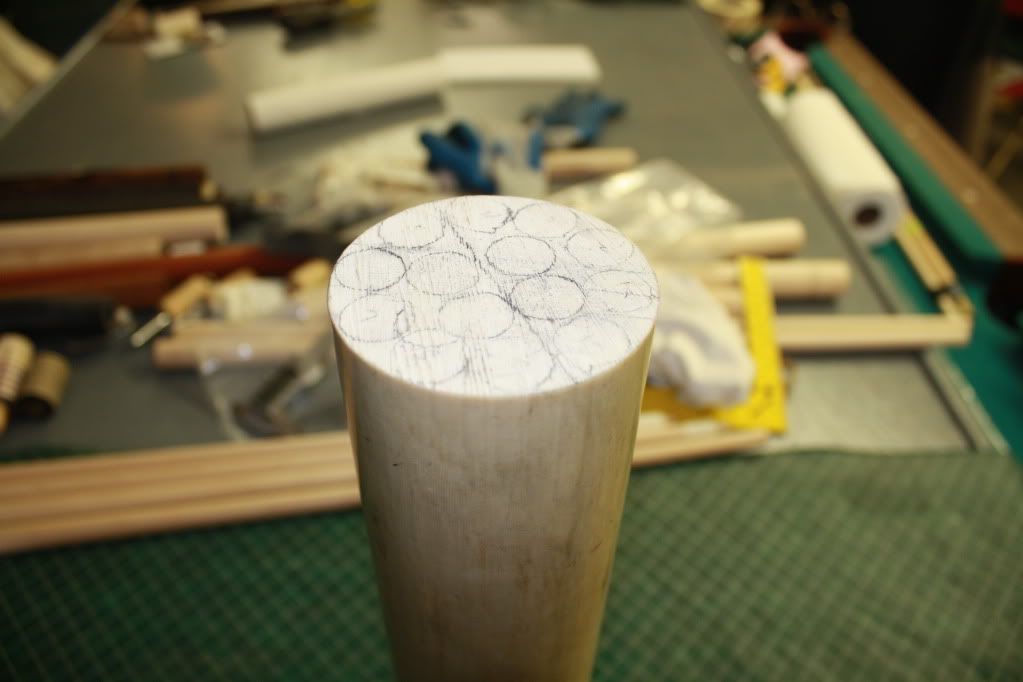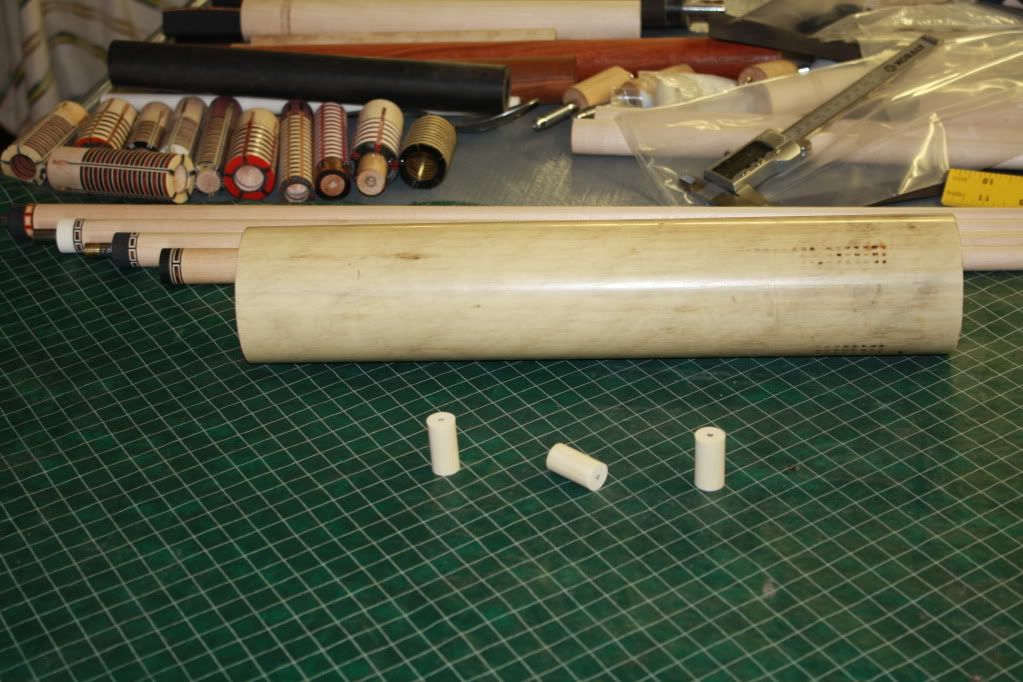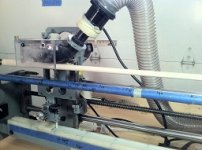I've seen ads on cues, that spotlight these, does this add value? are they rare? No longer made? Can someone fill me in on these please?! 
You are using an out of date browser. It may not display this or other websites correctly.
You should upgrade or use an alternative browser.
You should upgrade or use an alternative browser.
Whats the deal with Micarta ferulles?
- Thread starter PickPocket
- Start date
Much easier to do a search...
Josh
Josh
I've seen ads on cues, that spotlight these, does this add value? are they rare? No longer made? Can someone fill me in on these please?!
The "real" Micarta ferrula material has not been made for 35 plus years,
so they are indeed rare.
The reason they are expensive is that many of us feel they give a hit
that no other material - living or dead - can duplicate.
All this is, of course, subjective - but if you want the genuine article,
the cost is high.
Dale(Micarta maven)
I've seen ads on cues, that spotlight these, does this add value? are they rare? No longer made? Can someone fill me in on these please?!
People like the hit of Macarta ferrules, in most cases when people use the term Macarta they are referring to Westinghouse Macarta. This material was used for many years as an insulator for electrical connections by Westinghouse. The reason it is no longer made is because it has Asbestos in it, so it was taken off the market in favor of materials that were not carcinogenic. The real material will turn yellow after exposure to air over many years.
If you get a shaft that made with this material and you ever need to do any sanding on the ferrule you need to wear a mask and wash your hands very well after do so. It is also a good idea to do so outside if you do not have good ventilation where you are sanding it.
People like the hit of Macarta ferrules, in most cases when people use the term Macarta they are referring to Westinghouse Macarta. This material was used for many years as an insulator for electrical connections by Westinghouse. The reason it is no longer made is because it has Asbestos in it, so it was taken off the market in favor of materials that were not carcinogenic. The real material will turn yellow after exposure to air over many years.
If you get a shaft that made with this material and you ever need to do any sanding on the ferrule you need to wear a mask and wash your hands very well after do so. It is also a good idea to do so outside if you do not have good ventilation where you are sanding it.
According to tech people who worked there, Westinghouse only ever sold
Micarta containing asbestos to the Military. So, it is highly unlikely that
you are going to encounter any.
As explained previously, Westinghouse, and now Norplex(?), made many
plastics under the trademarked name "Micarta". Only one rather obscure
version is what established the reputation for Micarta as a ferrule material.
It was significantly different from all the others.
Dale
Wash your hands ?People like the hit of Macarta ferrules, in most cases when people use the term Macarta they are referring to Westinghouse Macarta. This material was used for many years as an insulator for electrical connections by Westinghouse. The reason it is no longer made is because it has Asbestos in it, so it was taken off the market in favor of materials that were not carcinogenic. The real material will turn yellow after exposure to air over many years.
If you get a shaft that made with this material and you ever need to do any sanding on the ferrule you need to wear a mask and wash your hands very well after do so. It is also a good idea to do so outside if you do not have good ventilation where you are sanding it.
Why? Is it poisonous?
Hi,
I am lucky enough to have a large piece of GE Macarta that I paid many thousands for 5 years ago. I bought it from Stew who acquired it in the 1970s in Cali. and had it in his trunk every since he came to Chicago in 1992. The rod I show here is 3" in dia. and was used to make insulators for 345 KVW high tension power transmission towers.
GE Micarta is much harder than Westinghouse sheet material that was pressed. The aggregate paper material was wound while the resin was added and it is much denser than Westinghouse. I sent a piece to theferrule hardness test that was done last year and was on You tube.
I have made many ferrules for customers and installed then on some of my select cues. The funny thing about this stuff is that even though it is very dense, it produces a very quiet hit unlike anything else.
I put a small ferrule on a Schuler Billiards Cue for a guy who plays at the local Moose Lodge that has 2 Verhooven Tables and a lot of billiards guys. Within 1 month, 9 players made the trek to my shop for theirs and they said the action is very noticeable. Regular pool player tell me that before they adjust to them that the cue ball shape after a shot produces more cut shots as the ball seems to roll farther.
When I drill the blind hole and turn the ferrules I must run the lath at only 400 rmp and use Tapclean cutting fluid to reduce the heat or the whole unit makes a small explosion sound and the ferrule cracks from the event. To be successful, I have to peck and step drill them with stub bits very carefully and clear the flukes and hole with air about every 3/16" of drill embedment while refilling the Tap Clean. When I first started using them I was seeing some stress cracks in the ferrules that did not explode and since I started my refined procedure they are flawless. When cutting this stuff it is wise to keep it wet to prevent inhalation of dust from the asbestos, IMO.
Rick G
I just cut 2 ferrules for a cue I am working on.

Close up of the ferrule cut from a sprial woven 3" GE Rod, The Westinghouse ferrules "al la" Runde, DPK, Franklin and others were much yellower than GE. The GE is a lighter yellowish color but does get a little yellower in time but never as dark as the Westinghouse.


This rod was 18" and now it is about only 12". Because I can not replace it, I am no longer selling ferrules and this will only be used on very select cues I build.

I am lucky enough to have a large piece of GE Macarta that I paid many thousands for 5 years ago. I bought it from Stew who acquired it in the 1970s in Cali. and had it in his trunk every since he came to Chicago in 1992. The rod I show here is 3" in dia. and was used to make insulators for 345 KVW high tension power transmission towers.
GE Micarta is much harder than Westinghouse sheet material that was pressed. The aggregate paper material was wound while the resin was added and it is much denser than Westinghouse. I sent a piece to theferrule hardness test that was done last year and was on You tube.
I have made many ferrules for customers and installed then on some of my select cues. The funny thing about this stuff is that even though it is very dense, it produces a very quiet hit unlike anything else.
I put a small ferrule on a Schuler Billiards Cue for a guy who plays at the local Moose Lodge that has 2 Verhooven Tables and a lot of billiards guys. Within 1 month, 9 players made the trek to my shop for theirs and they said the action is very noticeable. Regular pool player tell me that before they adjust to them that the cue ball shape after a shot produces more cut shots as the ball seems to roll farther.
When I drill the blind hole and turn the ferrules I must run the lath at only 400 rmp and use Tapclean cutting fluid to reduce the heat or the whole unit makes a small explosion sound and the ferrule cracks from the event. To be successful, I have to peck and step drill them with stub bits very carefully and clear the flukes and hole with air about every 3/16" of drill embedment while refilling the Tap Clean. When I first started using them I was seeing some stress cracks in the ferrules that did not explode and since I started my refined procedure they are flawless. When cutting this stuff it is wise to keep it wet to prevent inhalation of dust from the asbestos, IMO.
Rick G
I just cut 2 ferrules for a cue I am working on.

Close up of the ferrule cut from a sprial woven 3" GE Rod, The Westinghouse ferrules "al la" Runde, DPK, Franklin and others were much yellower than GE. The GE is a lighter yellowish color but does get a little yellower in time but never as dark as the Westinghouse.


This rod was 18" and now it is about only 12". Because I can not replace it, I am no longer selling ferrules and this will only be used on very select cues I build.

Last edited:
The sought after & popular micarta is the stuff with the laminated grain that looks similar to linear grain in ivory, and turns very yellow in time. That's the stuff that's expensive because everybody wants it. It used to be a popular material when it was available, and is reported to give a hit & feel like nothing else. There are lots of micarta materials out there but the only one that is the fabled "old stuff", has linear grain from flat lamination.
Richard Harris has the most I can think of. I will get a picture of a ferrule if I get a chance. It's easy to identify. But again, there's only one.
Richard Harris has the most I can think of. I will get a picture of a ferrule if I get a chance. It's easy to identify. But again, there's only one.
Wash your hands ?
Why? Is it poisonous?
Joe,
The dust from the asbestos contained therein can get in your lungs and it can cause Mesothelioma, a Lung Lining Cancer.
It is very wise to wear a mask, keep it wet and make sure you hands are wash after handling. Dale was giving very good good advise.
Rick
Last edited:
Joe,
The dust from the asbestos contained therein can get in your lungs and it can cause Mesothelioma, a Lung Lining Cancer.
It is very wise to wear a mask, keep it wet and make sure you hands are wash after handling. Dale was giving very good good advise.
Rick
Thanks.
I wear 3M respirator when sanding but I didn't know you had to wash your hands.
UThanks.
I wear 3M respirator when sanding but I didn't know you had to wash your hands.
Joe,
The asbestos micro particles are so small and lightweight that after the material dries it can become airborne.
I worked in power plants all my life (where the asbestos fell like snow, literally ) and many piping systems and big unit machinery was covered in asbestos insulation. I myself have been exposed to asbestos for over 30 years.
I takes many many years for the cancer to develop but they say only one spek of that stuff in your lung can do you in 20 to 30 years and yet many many people who have been exposed to bucket loads like my self are not affected. I hope I am in the later category.
Actually we have an death wish here in my shop and we grind up the Micarta at night when no one is looking and snort it up for kicks. It is like long term Russian Roulette.:wave2::help:
Seriously, I have noticed you are a cutting edge leader using horn and antlers and other natural materials on your fine cues. I am not too bright in organic chemistry but these material may be just as dangerous, who knows. Keep it safe, were a mask and duct you vacuum exhaust outside. Many people think using a shop vac helps them from health issues. If the vac exhaust is in the shop, anything particles smaller than your filter media is in you lungs.
Rick
Last edited:
Joe,
The asbestos micro particles are so small and lightweight that after the material dries it can become airborne.
I worked in power plants all my life (where the asbestos fell like snow, literally ) and many piping systems and big unit machinery was covered in asbestos insulation. I myself have been exposed to asbestos for over 30 years.
I takes many many years for the cancer to develop but they say only one spek of that stuff in your lung can do you in 20 to 30 years and yet many many people who have been exposed to bucket loads like my self are not affected. I hope I am in the later category.
Actually we have an death wish here in my shop and we grind up the Micarta at night when no one is looking and snort it up for kicks. It is like long term Russian Roulette. :wave2::help:
Seriously, I have noticed you are a cutting edge leader using horn and antlers and other natural materials on your fine cues. I am not too bright in organic chemistry but these material may be just as dangerous, who knows. Keep it safe, were a mask and duct you vacuum exhaust outside. Many people think using a shop vac helps them from health issues. If the vac exhaust is in the shop, anything particles smaller than your filter media is in you lungs.
Rick
That's true with everything that has dust so I have the suction right on the cutter.
Attachments
But again, there's only one.
Apparently not.
I love these post and cue maker inside stuff.. Very interesting
Apparently not.
I love these post and cue maker inside stuff.. Very interesting
Just one. All the others are cashing in on trying to be the one, but they aren't. Not to say the others aren't good material. They may be. But there's only one material people recognize as the old Westinghouse micarta, and it looks completely different from everything else. Whether or not it was actually made by Westinghouse, I don't know & really don't care. But I do know the material known as "Westinghouse micarta" and I have seen a lot of "old micarta" being pushed off as the good stuff but it's not the Westinghouse. I suspect it's a matter of trying to cash in on the popularity of the real thing, and/or a blatant lack of informed knowledge.
The stuff that's legitimately sought after is unlike anything else. Imagine a stack of paper being glued together, then put in a lathe & turned round. It's creamy color but you can see the lines between each layer of paper. Due to the resin, and I suspect the paper as well, it yellows with exposure. It looks unique. Nothing else I have seen is similar. There may be stuff that turns yellow, but nothing with the same grain pattern as the Westinghouse stuff.
Read for the truth:
http://forums.azbilliards.com/showpost.php?p=3115854&postcount=11
A pic comparing some more common versions:
http://dzcues.com/images/ferrule-images/micarta%20comparison.jpg
An old blank cut fresh:
http://dzcues.com/images/ferrule-images/k.jpg
Josh
http://forums.azbilliards.com/showpost.php?p=3115854&postcount=11
A pic comparing some more common versions:
http://dzcues.com/images/ferrule-images/micarta%20comparison.jpg
An old blank cut fresh:
http://dzcues.com/images/ferrule-images/k.jpg
Josh
Just one. All the others are cashing in on trying to be the one, but they aren't. Not to say the others aren't good material. They may be. But there's only one material people recognize as the old Westinghouse micarta, and it looks completely different from everything else. Whether or not it was actually made by Westinghouse, I don't know & really don't care. But I do know the material known as "Westinghouse micarta" and I have seen a lot of "old micarta" being pushed off as the good stuff but it's not the Westinghouse. I suspect it's a matter of trying to cash in on the popularity of the real thing, and/or a blatant lack of informed knowledge.
The stuff that's legitimately sought after is unlike anything else. Imagine a stack of paper being glued together, then put in a lathe & turned round. It's creamy color but you can see the lines between each layer of paper. Due to the resin, and I suspect the paper as well, it yellows with exposure. It looks unique. Nothing else I have seen is similar. There may be stuff that turns yellow, but nothing with the same grain pattern as the Westinghouse stuff.
The true "original" 'old yellow Westinghouse Micarta' was never,
and let me just repeat NEVER lamminated.
What you and Rick are refering to is one of many substitutes that
cue makers turned to after the first material was no longer available.
And, it hits like a rock. BTW - it was made from an entirely different resin.
Some people prefer that. But the appeal of the first stuff was that
it is solid, yet not hard.
Again, it all comes down to that highly subjective preference for "hit".
Marcus(FAST_N_LOOSE) probably knows as much about this stuff as
anybody, except for one guy.
Dale(Micarta maven)
According to tech people who worked there, Westinghouse only ever sold
Micarta containing asbestos to the Military. So, it is highly unlikely that
you are going to encounter any.
As explained previously, Westinghouse, and now Norplex(?), made many
plastics under the trademarked name "Micarta". Only one rather obscure
version is what established the reputation for Micarta as a ferrule material.
It was significantly different from all the others.
Dale
Dale I have to disagree with you respectfully. Now like you said if it was only sold to the Military from my experience it is not unlikely at all that you would encounter it. Almost all materials sold to the Military are later sold through DRMO to the civilian sector as scrape when they are no longer useful for their intended purpose. I remember back in the 1990's at FT. Lewis, Washington, the Army was changing it's side arm from the famous Colt M1911 45 Cal pistol to the 9mm. All the only 45's were sold in lots through DRMO, I bought a lot of five of the old M1911 Colts. I got five pistols for $155, and 3 of which were still fully functional.
Here is a link to their website with the goods they sell, anyone can sign up to purchase items and every Military Base has these items for sale.
http://recyclebiz.com/how_to_buy_surplus_property_from.html
Have a good day Dale.
Read for the truth:
http://forums.azbilliards.com/showpost.php?p=3115854&postcount=11
A pic comparing some more common versions:
http://dzcues.com/images/ferrule-images/micarta%20comparison.jpg
An old blank cut fresh:
http://dzcues.com/images/ferrule-images/k.jpg
Josh
Close, except for the lamminated sheets part.
In around 1990, I was told by the Product Manager of Micarta at Westinghouse
that it was not a lamminated material. He was very
familiar with it, said cuemakers, and even more knifemakers,
had been begging them to make 'one more batch' for years.
Perhaps they did in fact soak sheets and press them together.
But he said specifically, it wasn't lamminated, it wasn't phenolic,
and they never made it in rod form. All info counter to what I had
heard by the good ol' word of mouth.
Dale
Last edited:
Close, except for the lamminated sheets part.
In around 1990, I was told by the Product Manager of Micarta at Westinghouse that it was not a lamminated material. He was very
familiar with it, said cuemakers, and even more knifemakers,
had been begging them to make 'one more batch' for years.
Perhaps they did in fact soak sheets and press them together.
But he said specifically, it wasn't lamminated, it wasn't phenolic,
and they never made it in rod form. All info counter to what I had
heard by the good ol' word of mouth.
Dale
Soaking and pressing; how is that not a laminate? This info came directly from the "horse's mouth", Richard Welch, Vp Atlas Fibre Company.
Josh
